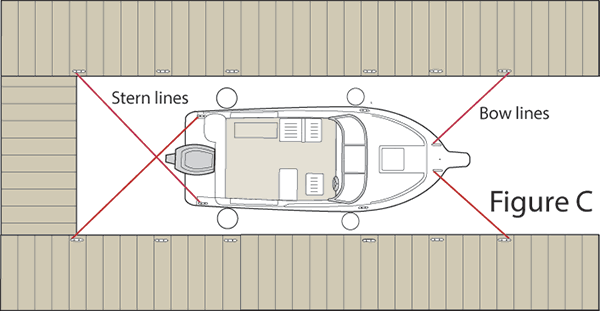How To: Secure Your Boat At The Dock
Unfortunately, most of us don’t get to spend as much time as we would like to on our boats. That means that our pride and joy spends a lot of time alone at the dock. Whether you use your boat daily, weekly, or only a few times each year, it’s important to know how to secure it at the dock. Below I will outline some recommended procedures for securing your vessel in a safe and efficient way so you can have ease of mind while you are off the water.
Choosing A Dock Line
Your dock line should have 1/8” of diameter for every 9’ of boat, with a minimum size of 3/8”. This means a 20’ boat should use a 3/8” line. A 40’ boat should use a 5/8” line. You can use a bigger line, and often boaters prefer this because a larger line is easier to grip.
The best material by far for dock lines is nylon, because it is stretchy and elastic, which allows it (not your boat’s deck hardware) to absorb sudden strains caused by wind, wakes, waves, and currents. This means less of a chance of hardware failure or structural damage to the boat and a nice, smooth ride while you’re tied up.
Caring For A Dock Line
Most dock lines are quite durable, and you may get several years of use out of them before you see any deterioration in performance. You should wash your lines with a simple brush and hose every few months to prevent build up on the lines. However, even with proper care, lines tend to get “gunky” over time, and many boaters elect to replace their lines every 2-3 years.
Dock lines are also prone to some stiffening from repeated dampness and drying out. To reduce the stiffness, a popular sailor’s trick is to place the dock lines in a pillowcase and wash them in the washing machine with a healthy dose of fabric softener.
Helpful Terms To Learn
Slack Line - A line that has no tension
Bow Line - Any line connected to the bow (front) of the boat
Stern Line - Any line connected to the stern (back) of the boat
Port / Starboard - Port is left, and starboard is right, when looking towards the front of the boat
Cleat - A fastening device that is designed to hold your lines
Fender - A cushion used to prevent contact between the boat and dock or surface
Floating Docks
The above diagram shows a common way to tie-up when you dock at a floating dock. The lines can be secured with minimum play since the dock and boat will rise and fall through the tide at the same rate. In both pictures above I would recommend bumpers / fenders on the port side.
Fixed Docks
The diagram above shows typical dock line routing for a fixed (non-floating) dock. In tidal areas, consideration must be given to tide variations. Notice the crossed stern lines. These are to help keep the vessel centered in the slip throughout tidal fluctuations. There are several other options that would work just as well in this situation. We would be happy to help you design a custom plan that best suits your boat and circumstances.
Quick Stops
The configuration above would be used during a short stop, such as getting fuel or having lunch or dinner. Notice only one spring line is used with multiple bumpers / fenders. With the addition of a few lines, this could be made safe and secure for longer stays.
Dockside Etiquette
When planning to pull up to a public dock or marina, it is always good to call ahead and ask for the availability of transient slips. They are often first come, first serve. Some may include a fee if you will be longer than a few hours. When pulling up to a gas stop, use common courtesy. Any boats who arrived before you are ahead of you in line. If you keep your boat in a slip, be a good neighbor. Keep your boat secure and minimize clutter in your area. Keep all hoses and lines coiled and put away.
While these are some of the most common docking configurations, each dock or slip may require a unique set-up. You must also consider things such as line diameter and type, chafing gear to reduce wear and tear, and the strength of attachment points both on your boat and the dock.
I hope you find this information helpful and, as always, please contact me with any specific questions you may have.
Fair Winds and Calm Seas,
Captain Ed



